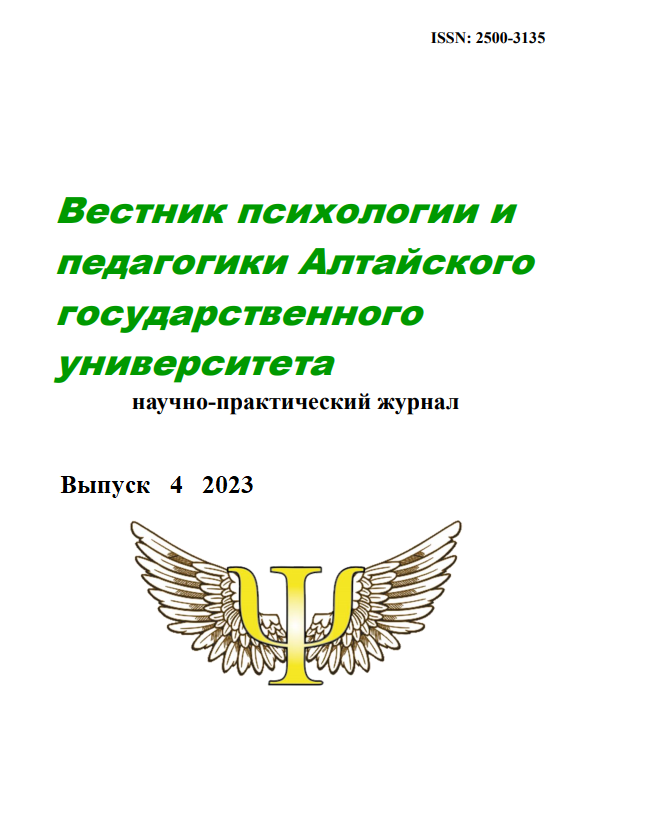ASPECTS OF THE PHYSICAL SELF-IMAGE OF WOMEN DOING YOGA
УДК 159.9
Abstract
This article is devoted to the study of a current phenomenon of modern psychology - the image of the physical “I”. The purpose of the study was to identify the features of the image of the physical “I” of women engaged in various areas of bodily practices, regardless of belonging to a certain age category. The sample consisted of 65 women aged 26 to 55 years, of which 33 were women practicing fitness and 32 women practicing yoga. The data were obtained using the method of V.A. Labunskaya “Evaluative and content-based interpretation of the components of external appearance.” The conducted mathematical and statistical analysis using Student’s t-test showed significant differences in the degree of satisfaction with the components of the image of the physical “I” between groups of women involved in yoga and fitness. The results obtained can be used to provide psychological support to women who are dissatisfied with their body image.
Downloads
References
Афанасьев В.П. "Йога-сутры" Патанджали: адаптированный практический комментарий. Москва: Амрита-Русь, 2014. 218 с.
Гавриленко А.А. Образ физического Я как структурная составляющая Я-концепции: автореф. дис. … канд. психол. наук М., 2009 22 с.
Лабунска я В.А . Психология самовыражения и проблема формирования «Я» личности // Прикладная психология. 1999. № 5. С. 52–75.
Лозенко К.С. Представления об образе физического Я в структуре самосознанания личности // Современные научные исследования и инновации. 2021. № 2. URL: https://web.snauka.ru/issues/2021/02/94618
Осьминина А.А. О современных исследованиях проблемы психологии внешнего облика человека // Вестник Костромского государственного университета. Серия: Педагогика. Психология. Социокинетика. 2019. № 1. URL: https://cyberleninka.ru/article/n/o-sovremennyh-issledovaniyah-problemy-psihologii-vneshnego-oblika-cheloveka
Психологические исследования внешности и образа тела: коллективная монография / отв. редактор А.Г. Фаустова. Рязань : ФГБОУ ВО РязГМУ Минздрава России, 2022. 223 с.
Тхостов А.Ш. Психология телесности. М. : Изд-во Смысл, 2002. 287 с.
Фомина О. С., Лучинкина И. С.Особенности физического Я личности // «Молодой учёный» . 2020. № 17 (307). С. 291–294.
Чернышова О.И., Лужбина Н.А. Ведущий уровень двигательной активности женщин, занимающихся «мягкими техниками» фитнеса / Труды молодых ученых Алтайского государственного университета материалы Ⅸ региональной молодежной конференции «Мой выбор – НАУКА», XLIX научной конференции студентов, магистрантов, аспирантов и учащихся лицейских классов. Вып.19. Барнаул: Изд. Алт. ун-та, 2022. С. 194–197.
Шутова Н.В., Суворова О.В., Куасси А.П. Влияние физического образа «Я» на самоотношение формирующейся личности // Современные наукоемкие технологии. 2015. № 12 (часть 1). С. 169–174.
References:
Afanas'ev V.P. "Joga-sutry" Patandzhali: adaptirovannyj prakticheskij kommentarij. Moskva: Amrita-Rus', 2014. 218 p.
Gavrilenko A.A. Obraz fizicheskogo YA kak strukturnaya sostavlyayushchaya YA-koncepcii: avtoref. dis. … kand. psihol. nauk M., 2009 22 p.
Labunska ya V.A . Psihologiya samovyrazheniya i problema formirovaniya «YA» lichnosti // Prikladnaya psihologiya. 1999. No 5. P. 52–75.
Lozenko K.S. Predstavleniya ob obraze fizicheskogo YA v strukture samosoznananiya lichnosti // Sovremennye nauchnye issledovaniya i innovacii. 2021. № 2. URL: https://web.snauka.ru/issues/2021/02/94618
Os'minina A.A. O sovremennyh issledovaniyah problemy psihologii vneshnego oblika cheloveka // Vestnik Kostromskogo gosudarstvennogo universiteta. Seriya: Pedagogika. Psihologiya. Sociokinetika. 2019. No 1. URL: https://cyberleninka.ru/article/n/o-sovremennyh-issledovaniyah-problemy-psihologii-vneshnego-oblika-cheloveka
Psihologicheskie issledovaniya vneshnosti i obraza tela: kollektivnaya monografiya / otv. redaktor A.G. Faustova. Ryazan' : FGBOU VO RyazGMU Minzdrava Rossii, 2022. 223 p.
Thostov A.SH. Psihologiya telesnosti. M. : Izd-vo Smysl, 2002. 287 p.
Fomina O. S., Luchinkina I. S.Osobennosti fizicheskogo YA lichnosti // «Molodoj uchyonyj» . 2020. No 17 (307). P. 291–294.
CHernyshova O.I., Luzhbina N.A. Vedushchij uroven' dvigatel'noj aktivnosti zhenshchin, zanimayushchihsya «myagkimi tekhnikami» fitnesa / Trudy molodyh uchenyh Altajskogo gosudarstvennogo universiteta materialy Ⅸ regional'noj molodezhnoj konferencii «Moj vybor – NAUKA», XLIX nauchnoj konferencii studentov, magistrantov, aspirantov i uchashchihsya licejskih klassov. Vyp.19. Barnaul: Izd. Alt. un-ta, 2022. P. 194–197.
SHutova N.V., Suvorova O.V., Kuassi A.P. Vliyanie fizicheskogo obraza «YA» na samootnoshenie formiruyushchejsya lichnosti // Sovremennye naukoemkie tekhnologii. 2015. No 12 (chast' 1). P. 169–174.
Bulletin of Psychology and Pedagogy of Altai State University is a golden publisher, as we allow self-archiving, but most importantly we are fully transparent about your rights.
Authors may present and discuss their findings ahead of publication: at scientific conferences, on preprint servers, in public databases, and in blogs, wikis, tweets, and other informal communication channels.
Bulletin of Psychology and Pedagogy of Altai State University allows authors to deposit manuscripts (currently under review or those for intended submission) in non-commercial, pre-print servers such as ArXiv.
Authors who publish with this journal agree to the following terms:
- Authors retain copyright and grant the journal right of first publication with the work simultaneously licensed under a Creative Commons Attribution License that allows others to share the work with an acknowledgement of the work's authorship and initial publication in this journal.
- Authors are able to enter into separate, additional contractual arrangements for the non-exclusive distribution of the journal's published version of the work (e.g., post it to an institutional repository or publish it in a book), with an acknowledgement of its initial publication in this journal.
- Authors are permitted and encouraged to post their work online (e.g., in institutional repositories or on their website) prior to and during the submission process, as it can lead to productive exchanges, as well as earlier and greater citation of published work (See The Effect of Open Access).







